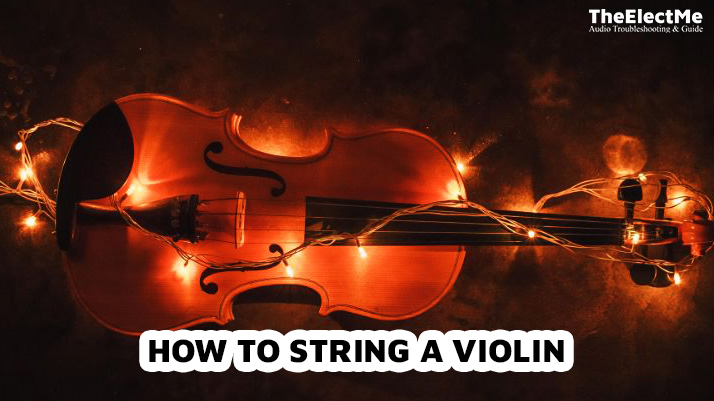Who doesn’t want to create beautiful music with a violin? However, you must know how to string a Violin or instrument correctly before playing. A single wrong move can result in broken strings or an out-of-tune violin.

Violin stringing can seem like a daunting task, especially for first-timers. But with proper guidance and practice, you can easily do it yourself.
So, let’s start with the preparation you can do before you begin stringing your violin.
What Are The Steps To Prepare Your Violin For Stringing?
Before stringing your violin, you must adequately prepare your instrument and work area. Learning violin is hard, so it takes time. Here are some steps you should keep in mind when stringing a violin.
Removing Old Strings
Removing old strings is your first step. Take your time with this process; sudden removal can damage the violin’s bridge. Instead, gently unwind the tuning pegs to loosen each string, starting from the thickest to the thinnest. Once reduced, you can safely remove the strings from the tailpiece and peg holes.
Positioning Your Violin
Make sure you’re working on a flat, stable surface. To protect your violin from scratches, consider laying down a soft cloth beneath it. Hold the violin with the chin-rest facing you for a good view of the peg box and the tailpiece. This position will help you accurately thread the strings through the correct peg holes.
Remember, patience is vital in this process. Taking your time to remove old strings and position your violin correctly can prevent unnecessary damage and ensure the longevity of your instrument.
After preparing your violin, you can move on to the stringing process.
How To String A Violin? A Step-By-Step Guide
Now that you’ve prepared your violin, it’s time to start stringing. This process involves placing the strings correctly on the tailpiece, threading them through the tuners, and adjusting the pegs.
Placing the Strings on the Tailpiece
First, take the new string and locate the nub or ball end. This end will be placed in the arms of the tailpiece, situated at the bottom of your violin. Ensure the string is securely seated in the tailpiece to avoid popping out later.
Threading the Tuner End
Next, thread the other end of the string into the corresponding tuning peg hole. Remember to keep a gentle tension on the string to prevent it from slipping out of the tailpiece. Once threaded, start turning the peg to wind the string. Be careful not to over-tighten, as this can snap the string.
Loosening and Tightening the Pegs
Finally, you must adjust the pegs to get the right pitch. To do this, loosen the peg slightly, then gradually tighten while plucking the string. Listen carefully for the correct pitch – each string should match a specific note (G, D, A, E from lowest to highest).
Once in tune, you can cut off any excess string length with a wire cutter.
Remember, the goal is to apply enough tension to hit the right note. Too much stress could break the string, while too little will result in a dull, flat sound.
After completing these steps, let’s move to the bridge setup.

How Do You Set Up The Bridge Of Your Violin?
A correctly placed bridge is crucial for your violin’s excellent sound quality and playability.
Firstly, you need to identify the two sides of the bridge. The bridge needs to be symmetrical; one side is slightly taller than the other. The higher side is for the G string (the thickest string), and the lower is for the E string (the thinnest string).
Once you know the sides, slide the bridge under the strings and stand it upright. The back of the bridge (the side facing the tailpiece) should be perpendicular to the violin’s top, while the front of the bridge should have a slight backward slant. The bridge feet should sit firmly on the violin without any gaps. How can I make violin practice for my child? Simply by setting goals and adding some excitement.
Bridge setup may seem complicated, but you can do it correctly with some practice. After, you can tune your violin and start playing. Let’s explore the process of adjusting a violin.
How Do You Fine-Tuning Your Violin?
After setting up the bridge and stringing the violin, it’s time for fine-tuning.
Start with the G string and work your way to the E string. Use a digital tuner or a tuning app for accuracy.
Pluck the string while slowly turning the tuning peg. Watch the tuner and adjust until you reach the correct note for each string (G, D, A, E).
For more precise adjustments, use the fine tuners located on the tailpiece. Turning them clockwise tightens the string (raising the pitch), and counter-clockwise loosens it (lowering the pitch). Make minor adjustments until each string is ideally in tune.
Remember, tuning is a delicate process. Always turn the pegs and fine-tuners gently to avoid breaking the strings.
Conclusion – How To String A Violin?
In conclusion, stringing a violin is a delicate task that requires care and precision. Every step is crucial in ensuring your violin sounds its best, from removing old strings to placing new ones, positioning the bridge, and fine-tuning each string. It’s not just about replacing worn-out strings; it’s about understanding your instrument and enhancing its performance.
With continuous practice, you’ll become more comfortable with this process and gain a deeper appreciation for your violin. So, don’t shy away from learning and experimenting. This hands-on experience will help you maintain your instrument and strengthen your connection with the music you create.
Remember, every great musician starts somewhere; mastering the art of stringing your violin could be your first step toward greatness.



